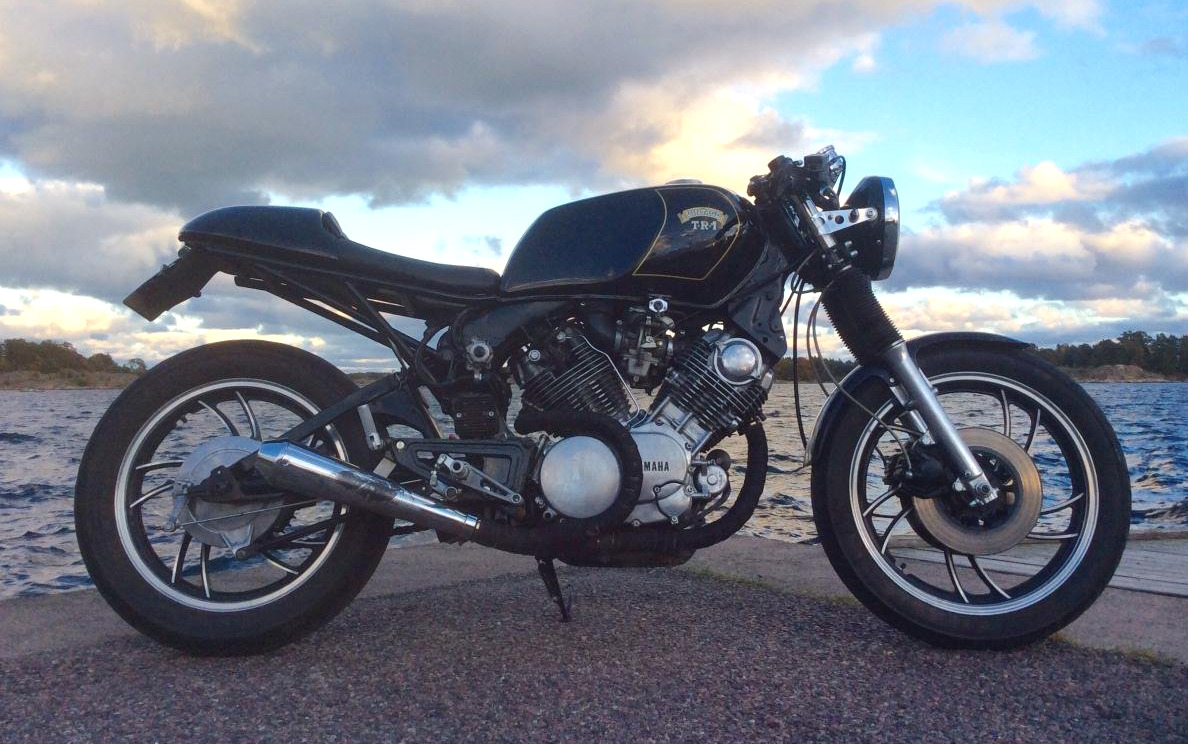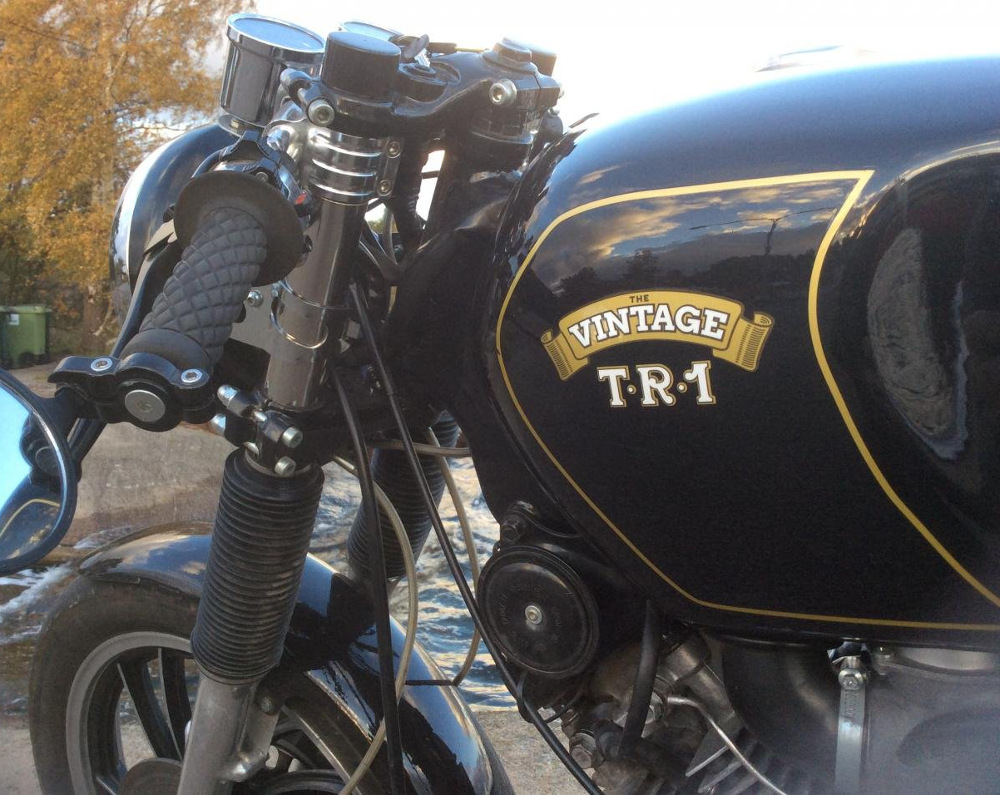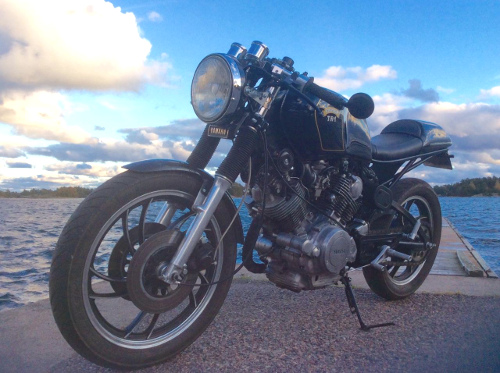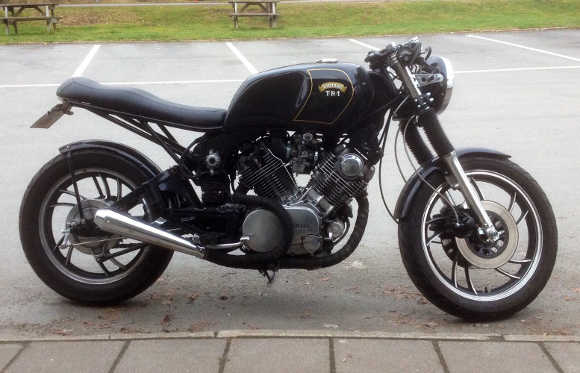
Oj, oj!! Här är det kanske risk för att någon reagerar med ryggmärgen och får sura uppstötningar. En japshoj som försöker utge sig för att vara Vincent. Nä, så är det ju inte. Ingen som kan läsa vad det står på tanken kan missta den för en Vincent, däremot är den en ärlig hyllning till vårt kära fabrikat.
Själv ser jag det som hedrande att Vincent, som konstruerades redan på 30-talet (om vi räknar med Series A) fortfarande kan vara en förebild både för konstruktörer och hemmabyggare. Det finns lite för många likheter mellan TR-1 och Vincent för att man inte skall förstå vad japanerna tittade på när de konstruerade TR-1:an.
Om Vincent hade kunnat fortsätta efter 1955 är det inte helt otänkbart att en modern Vincent, Series E ?, hade sett ut ungefär på det här sättet.
Oops! Some of you may feel a sudden and clear sense of nausea. A Jap bike pretending to be a Vincent?
Not really so.
No one, who is able to read, can miss the text on the fuel tank, and the purpose with this build is probably to create a tribute to our beloved Vincent brand than to make a tacky copy.
Isn't it a bit of an honour that a bike designed in the 30-ies (Series A) can still be regarded as a "role model" by modern day cafe racer builders and bike manufacturers?
Between the Vincent and the TR-1 there are just a bit too many similarities for one not to understand what the Japanese were aiming at when they created the TR-1. They checked out The Vincent!
If Vincent could have continued after 1955 this might be what a modern Vinnie would look like.
Not really so.
No one, who is able to read, can miss the text on the fuel tank, and the purpose with this build is probably to create a tribute to our beloved Vincent brand than to make a tacky copy.
Isn't it a bit of an honour that a bike designed in the 30-ies (Series A) can still be regarded as a "role model" by modern day cafe racer builders and bike manufacturers?
Between the Vincent and the TR-1 there are just a bit too many similarities for one not to understand what the Japanese were aiming at when they created the TR-1. They checked out The Vincent!
If Vincent could have continued after 1955 this might be what a modern Vinnie would look like.



Hojen är byggd av Björn Holst och så här såg den ut innan cutsen kom på dynan.
The bike here was built by Björn Holst and this photo was taken before the cuts mod was done to the seat.
|
Det är inte bara vi Vincent-människor som ser kopplingen mellan Vincent och TR-1. Så här beskrevs TR-1 i en sentida presentation:
|
Not only Vincent enthusiasts can see the connection between Vincent and TR-1. This is a modern presentation of the TR-1.
|
|
Yamaha made much of their brand-new cantilever rear suspension - the first time on a four-stroke - never mind that Vincent HRD had used a very similar design starting way back in the 1930s. In fact, the TR1 could be said to be quite close in layout to the classic Stevenage twins. It shared a few characteristics, in that the barrels appeared loosely based on that of the SR500 single (They weren't; they were a new design which just looked similar), 'doubled up', just like the popular legend which has Phil Irving, Philip Vincent's friend and chief designer, accidentally overlaying two drawings of the 500cc single cylinder Comet engine to come up with the V-twin. It's debatable whether it actually happened that way, but it's a good story!
The TR1 also, unusually for a Japanese machine, had a vertically split crankcase, just like the old British bikes. There was virtually no frame in the conventional sense, the bike instead relying on a pressed steel spine, which bolted onto the top of the engine to support the headstock, shock and swinging arm. |
|
|
TR-1 kom 1981 men blev aldrig någon riktig storsäljare med japanska ögon mätt. Inte så konstigt, hojen var helt enkelt ful. Efterföljarna i Virago-serien gjorde däremot jättesuccé under många år.
Tekniskt hade den en hel del gemensamt med Vincent : bakfjädringen, den minimala ramen med motorn som bärande element, vertikalt delat vevhus och cylindrarna en vevlagerbredd förskjutna i sidled samt en slagvolym på strax under 1000 cc. |
 |
|
The TR-1 appeared in 1981 but was not a winner in number of sold bikes. Not to wonder, the bike was simply a pretty ugly one!
Its followers in the Virago class on the other hand, were a success for many years. Technically it did resemble the Vincent in many respects. The rear suspension, the minimalistic frame using the engine as a stressed member, and the off-set cylinder design together with an engine size of just under 1000cc. |
|